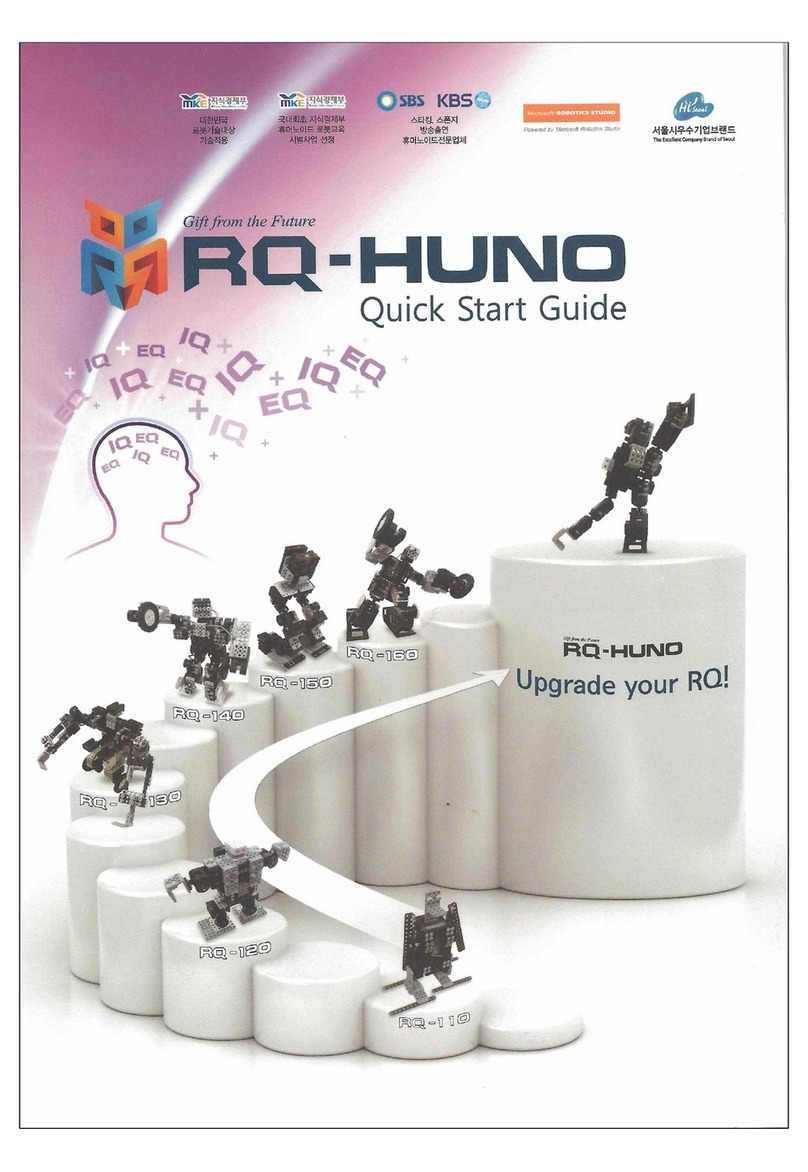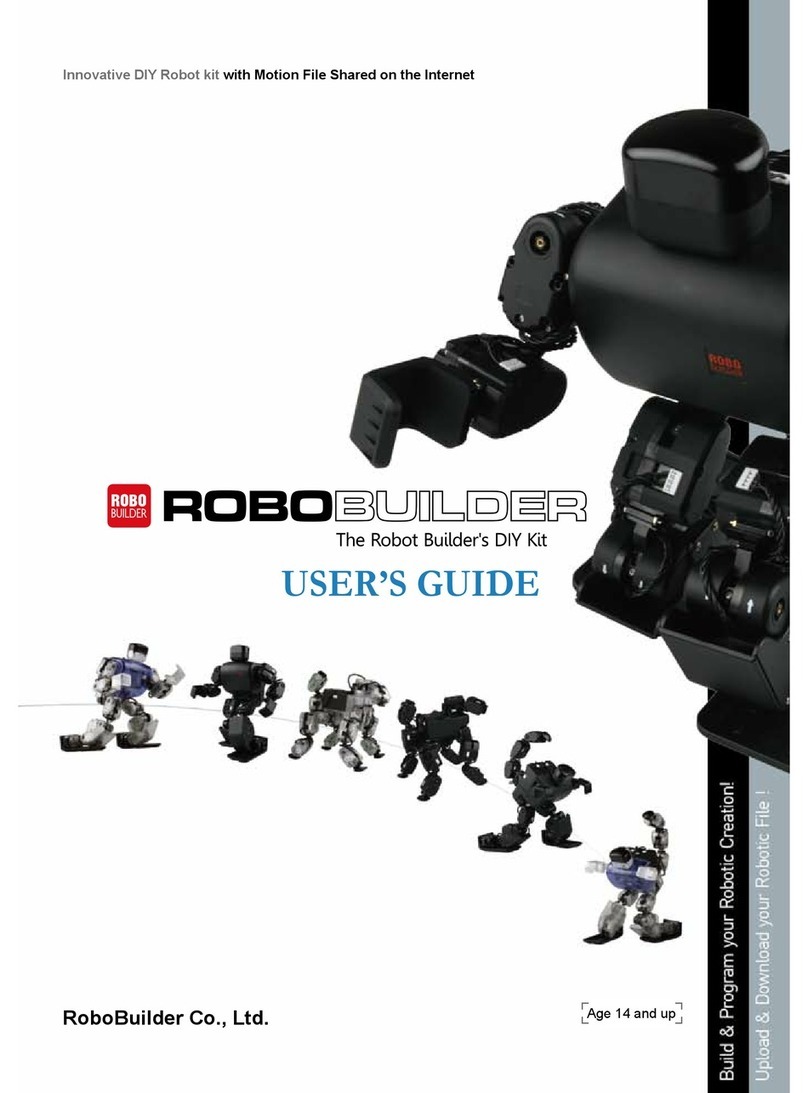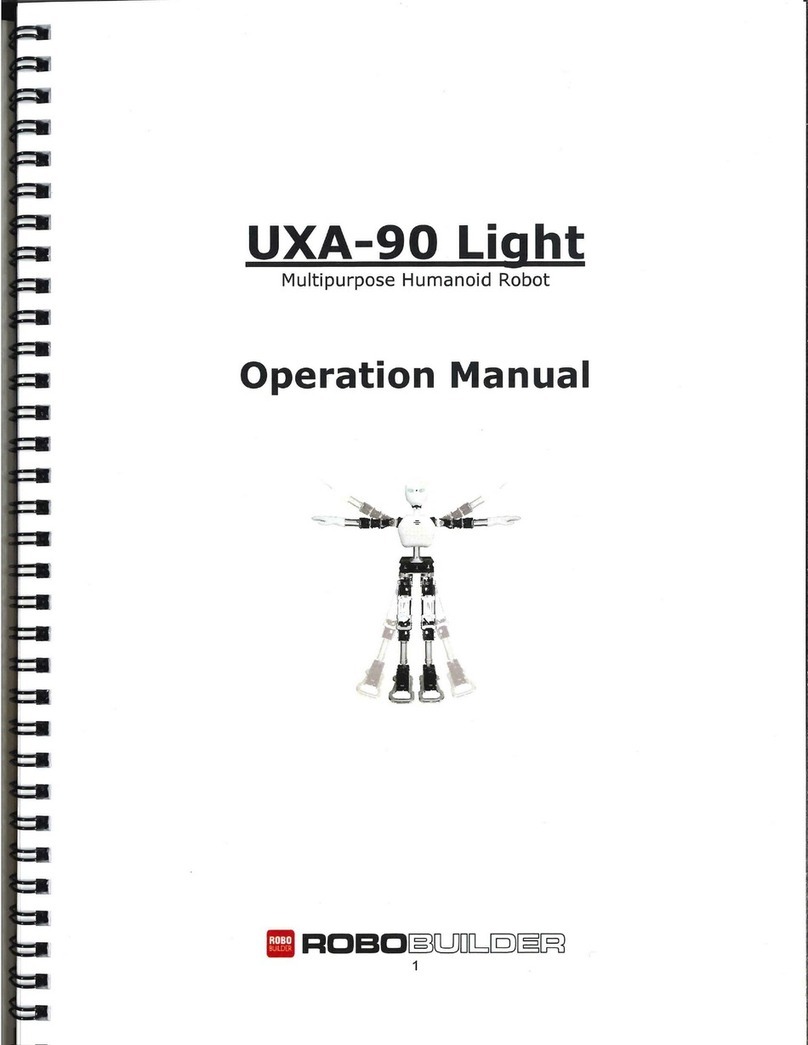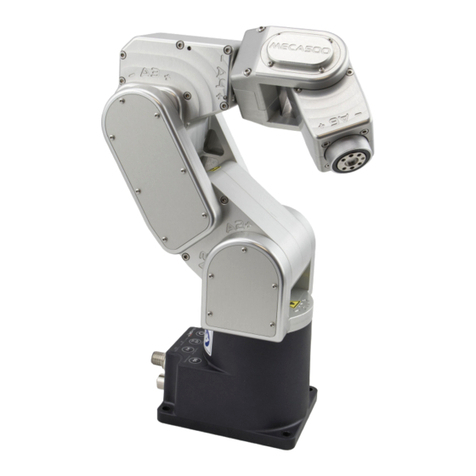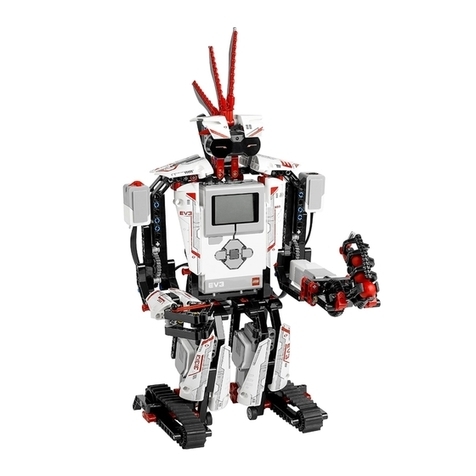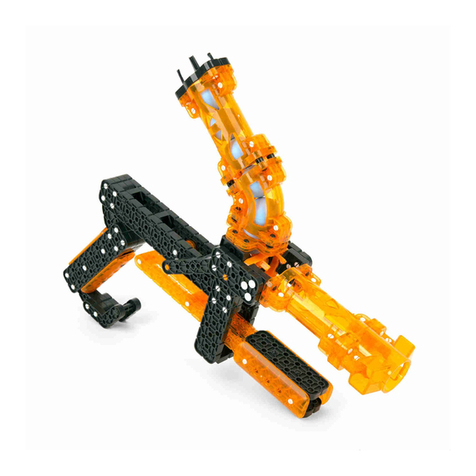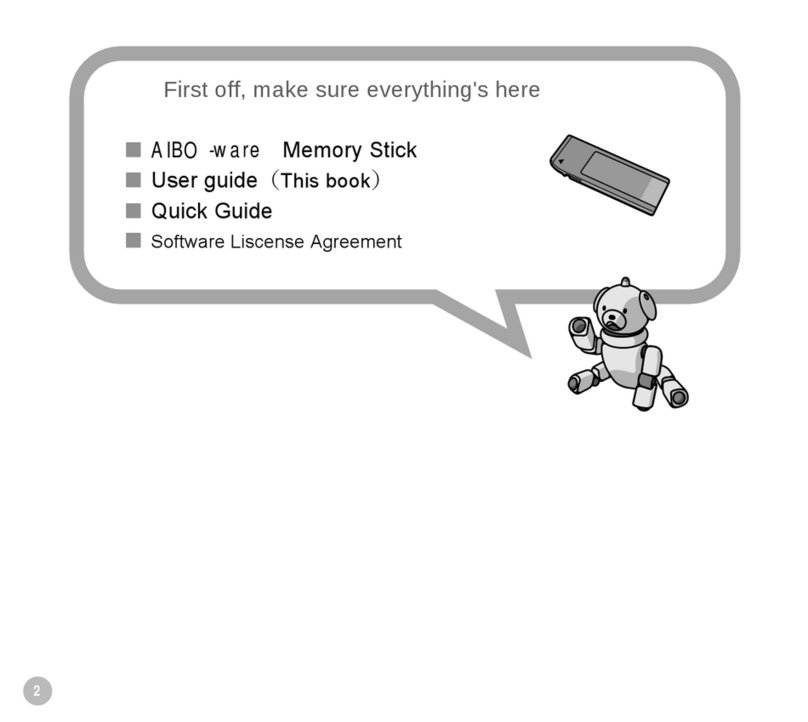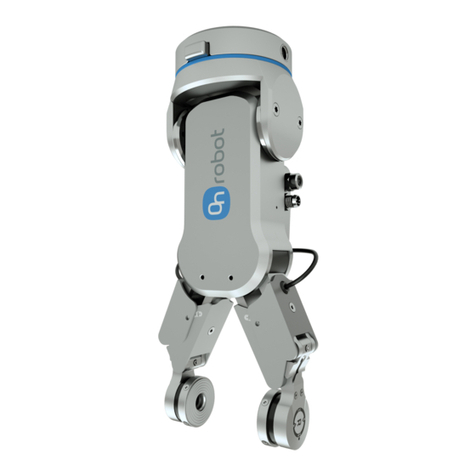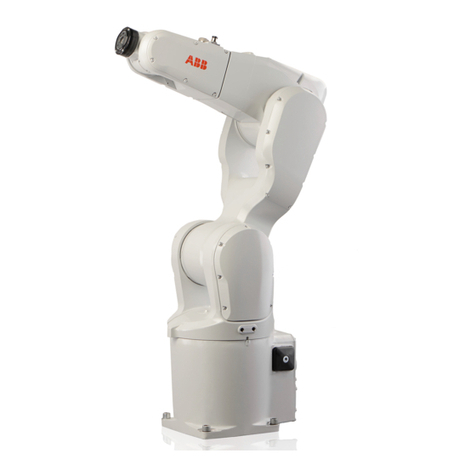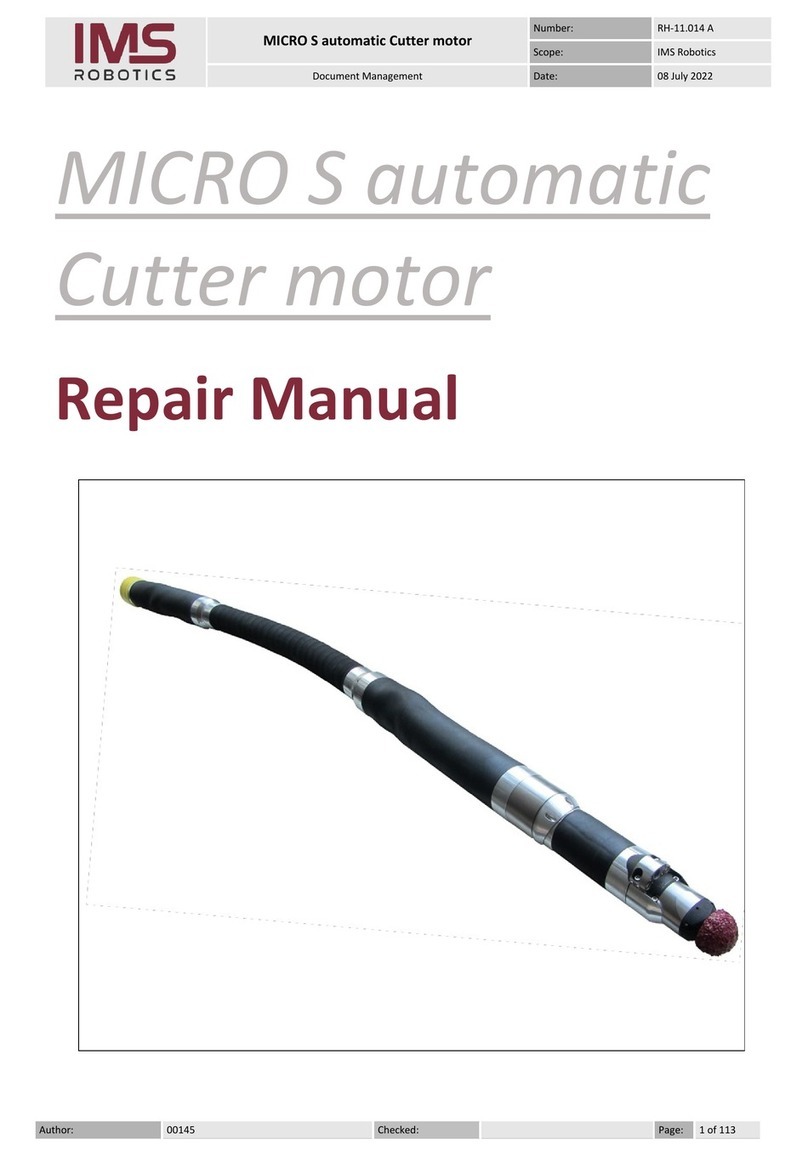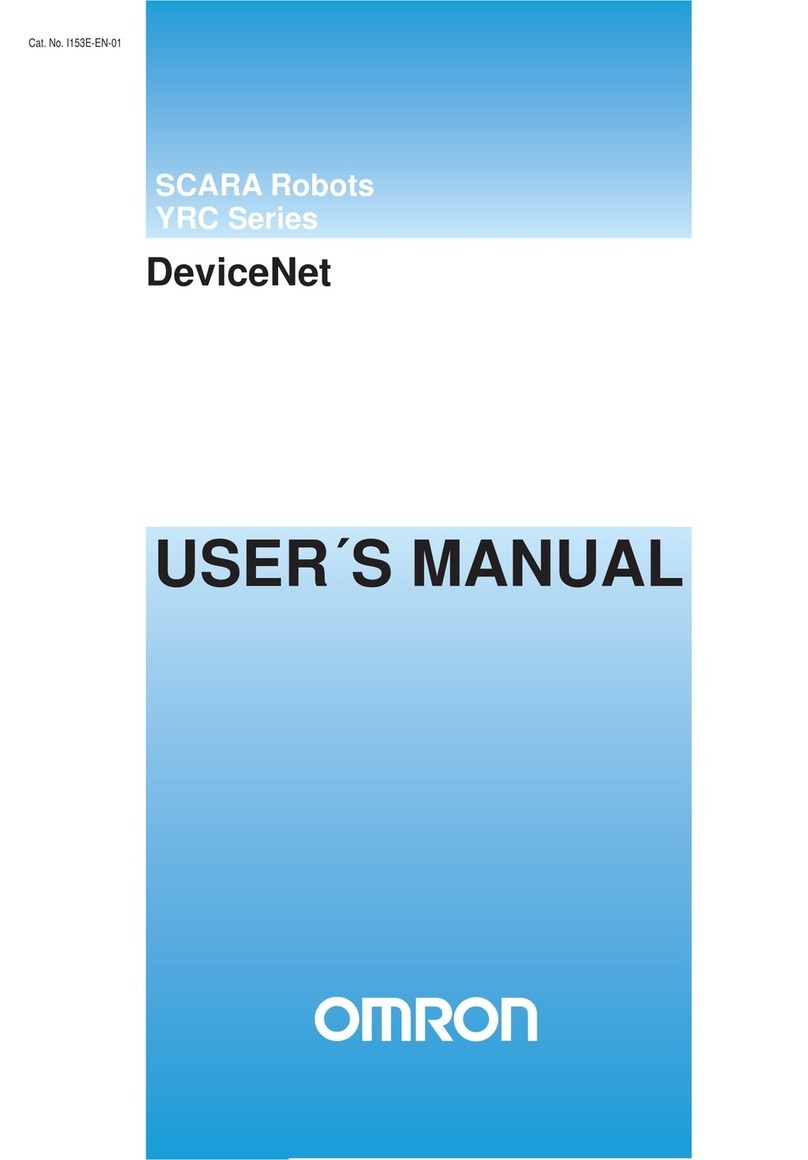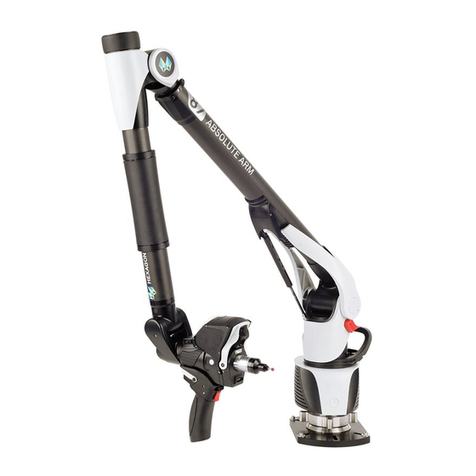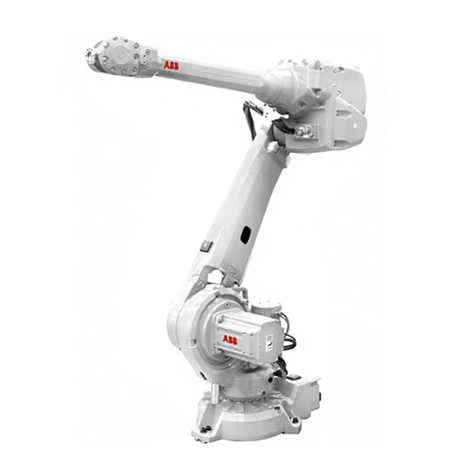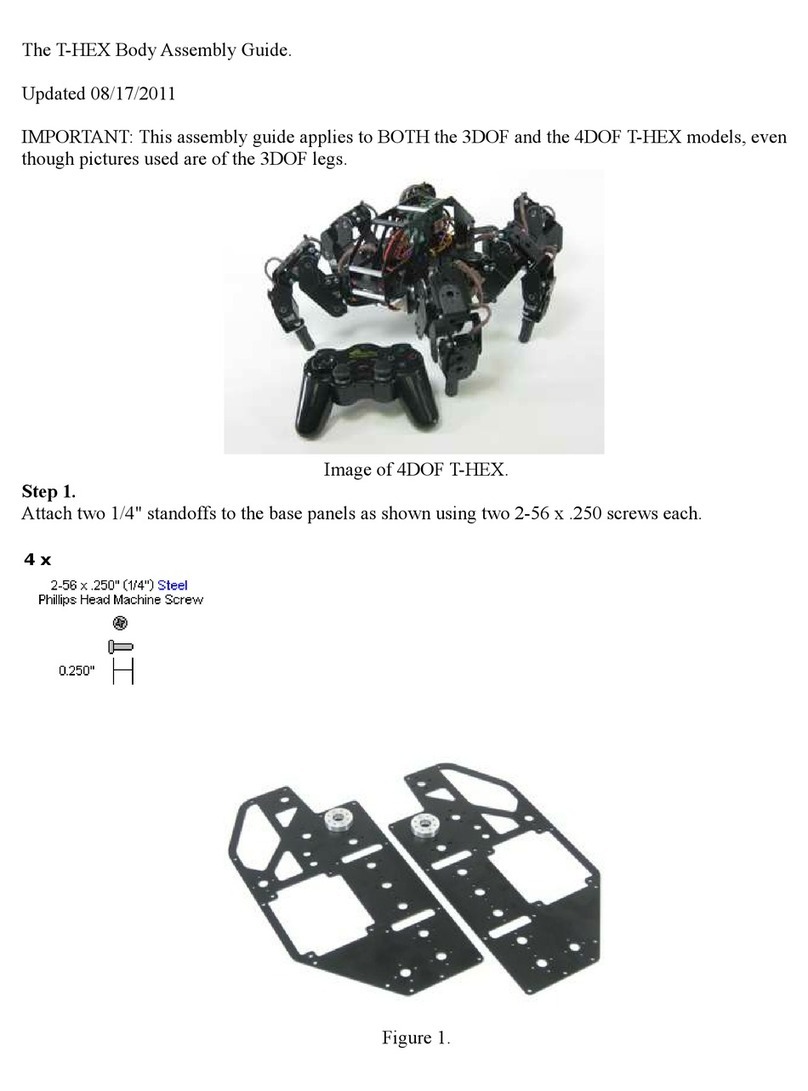RoboBuilder wCK series User manual

wCK series
User’s Manual
Intelligent Modular Robot
Ver 1.07

2/71
User’s Manual v1.07 wCK series
TABLE OF CONTENTS
1.INTRODUCTION p3
1-1 Introduction p3
1-2 Model Listing p4
1-3 Main Specifications p5
1-4MainFeatures p5
1-5 Control Scheme p7
1-6Application p8
1-7 Part List p10
1-8 Mechanical Specifications p10
1-9 Electrical & Control Specifications p12
2.USINGwCKMODULE p13
2-1 Mechanical Connection p13
2-2 Electrical Connection p20
2-3 Communication p22
2-4 Software p25
3.CONTROLFUNCTIONS p26
3-1 Position Control p27
3-2 Synchronized Position Control p29
3-3 Passive Mode p30
3-4 Speed/Acceleration Setting p30
3-5 Movement Boundary Setting p30
3-6 Reverse-voltage Protection p30
3-7 Over-current Protection p30
3-8 Wheel Mode p30
3-9 Break Mode p30
3-10 External I/O Port p31
3-11 Self-running Motion p32
3-12 Initialization of wCK ID and Baud rate p33
A.APPENDIX p34
A-1 Communication Protocol p34
A-2 Communication Voltage Translation Circuit Board p59
A-3 Baud rate Setting for Independent Controller p60
A-4 Application Example p63
A-5DefaultParameterSettings p70
A-6 Protocol Table p71

3/71
User’s Manual v1.07 wCK series
1 INTRODUCTION
1-1 Introduction
RoboBuilder’s wCK module is an intelligent robotic module with which users can build creative robots of various shapes and easily
operate and control robots. It is the first block type robotic module in the world that has a joint insertion assembly structure. This quick
and simple joint assembly scheme enables users to simply plug a plastic joint part into wCK modules to mechanically link two different
wCK modules, which dramatically helps reduce building time. Internally a control board and a servo actuator mechanism are integrated
together within the small plastic enclosure. The wCK module itself can operate as a small independent robot system because it is
equipped with external I/O ports and can run a self-running motion program. The wCK module adopt a PID motion control technology
and realized motion control characteristics as precise and accurate as industrial servo motors. Users can design and build robotic systems
with multi-axis articulated mechanism much more easily and efficiently by adopting wCK robotic modules. This is because the wCK
module is designed for users to easily extend functionality and to fast track troubleshooting and maintenance.
[Figure 1-1a] Picture of wCK module(packaged)
[Figure 1-1b] Picture of wCK module

4/71
User’s Manual v1.07 wCK series
1-2 Model Listing
The series name “wCK” comes from the sound “Wingchick” that the actuator module makes when in motion.
[Figure 1-2a] Model Name Scheme
[Figure 1-2b] Model Listings

5/71
User’s Manual v1.07 wCK series
1-3 Main Specifications
Communication Multi drop Full Duplex UART serial communication
Baud Rate 4,800bps ~ 921,600bps(8 levels)
Extension Max 254 modules per channel(ID 0~253)
Operating Voltage 6VDC ~ 10VDC(7.4VDC~8.4VDC recommended)
Speed Max No Load Speed 0.15 sec/60˚(wCK-1108 under recommended voltage)
Stall Torque Max 13kg·cm(wCK-1413 under recommended voltage)
Max Power 1.1W(wCK-1108, 1111), 1.4W(wCK-1413)
Gear Ratio 1/173(wCK-1108), 1/241(wCK-1111, 1413)
Control Mode Position Control, Speed Control, Torque Control
Control Angle 0~254(Standard Resolution), 0~1,022(High Resolution)
Operating Angle 0˚~269˚(Standard Resolution), 0˚~333˚(High Resolution)
Resolution 8 bit/1.055˚(Standard Rosolution), 10 bit/0.325˚(High Resolution)
Error Range ±0.8˚(Standard Resolution)
Speed Level 30 levels(Position Control Mode), 16 levels(Wheel Mode)
Case Material Engineering Plastic
Gear Material POM(wCK-1108), POM+Metal(wCK-1111,1413)
Size 51.6 mm27.1 mm36.4 mm
Weight 45g(wCK-1108), 49g(wCK-1111,1413)
1-4 Main Features
All-in-OneIntegrated RobotModule
All components such as the controller, the sensor, the actuator, and the I/O port are integrated in a small plastic enclosure.
CompactDesign
Compact and elegant exterior design with smooth curved lines enhances its functionality as well as helps efficient mechanical system
designing.
2 WayMechanical Power Transmission
2 way mechanical power transmission structure enables users to build various structures of mechanical systems.
Quick& SimpleJoint Assembly
Quick and simple joint assembly scheme enables users to simply plug a plastic joint into wCK modules to connect wCK modules,
which helps to generate creative robots and dramatically reduce building time.
Presice PID Control
Position control error of ±0.8˚realized through precise PID control(in Standard Resolution)
High resolution Mode 10 bit 1,024 steps(unit control angle 0.325˚),
Standard Resolution Mode 8 bit 256steps(unit control angle 1.055˚)

6/71
User’s Manual v1.07 wCK series
ErrorCompensation Algorithm
Special algorithm for position error compensation realized ±0.8˚level of error with low resolution potentiometer feedback.
PositionControl, SpeedControl, Torque Control
Three different control modes help users apply wCK module to systems with various control requirements.
VariousOperation Mode
Position control mode, Synchronized position control mode, Wheel mode, Passive mode, Break mode, Self-running mode, etc
VariousParameters
Various parameters configurable such as wCK ID, Baud rate, Position control resolution, PID gains, Movement speed, Acceleration
range, Motion Boundary, Max operation current, etc
MultiDrop FullDuplex UARTserial communication
The Full Duplex UART two-way serial communication enables to connect to wCK directly without using separate communication
device from external controller.
ControlOptimizedProtocol
Minimized communication time delay by adopting optimized protocol structure and real-time response method for all commands.
ExternalI/O Port
1channel A/D input(0V~5V), 2channels Digital Output(TTLlevel)
Self-runningMotion
wCK can run a motion and sensor interaction by itself without being controlled by external controller
VariousSpeed Levels
30 levels in position control mode, 16 levels in 360˚wheel mode
Voltage-adaptive Automatic Adjustmentof Control Angle
wCK module can implement automatic compensation for control output according to real-time input voltage
Windowsbased ProgrammingSoftware
Windows-based software such as wCK programmer, Motion Builder, Action Builder
Widerange ofInput Voltage
Wide range of input voltage (6VDC~10VDC)

7/71
User’s Manual v1.07 wCK series
Widerange ofControl Angle
0˚~269˚in standard resolution, 0˚~333˚in high resolution
Power-savingBreak Mode
Break mode stops the motion of a wCK module and thus help hold still system’s mechanical structure without consuming electric
power by using dynamic break effect.
PassiveSensor Mode
In passive mode, wCK releases torque and acts as a sensor
Reverse-voltageProtection,Over-current Protection
Protection circuits built-in for reverse-voltage and over-current
Initialization ofID andBaud Rate
wCK ID and baud rate can be initialized for debugging or troubleshooting purpose
TwoMetalBearings for MechanicalDurability
Mechanical durability is ensured with two metal bearings applied on the rotation axis
1-5 Control Scheme
wCK module can be controlled by RoboBuilder’s RBC controller, general puupose MCUs, as well as directly by a PC. The RBC
controller can be used to connect the PC to the wCK modules as the RBC controller has circuitry to convert the RS232 signals to
voltage levels used on the wCK's communication network. A separate voltage translation circuit may be required when using a MCU or
a PC to control a wCK module. RoboBuilder provides this separately as a voltage translator circuit board (refer to Appendix A-2 for
detail).
[Figure 1-5a ] Using RBC controller

8/71
User’s Manual v1.07 wCK series
1-6 Application
The wCK module can be applied to various types of articulated robot platforms for purposes such as R&D, toys and entertainment,
game and amusement, commercial, and educational purposes. It can also be used for systems that require multi-axis movement such as
medical devices, tool sets for science and education etc. The self-running motion of the wCK module helps to build a simple and
compact stand alone system too.
[Figure 1-5b ] Using general-purpose MCU
[Figure 1-5c ] Direct PC Control without external controller

9/71
User’s Manual v1.07 wCK series
[Figure 1-6a] Application(Various Articulated Robots)

10/71
User’s Manual v1.07 wCK series
1-7 Part List
Part List
No Qty PartName Use 도
11 EA wCK module Intelligent wCK robot module
21 EA Round Joint Transmit force of wCK module to external object
31 EA wCK Cable (4wire twisted) Wiring cable for wCK module
44 EA Bolt 1 (M240mm) Fix wCK module onto external object
54 EA Nut (M2) Fix wCK module onto external object
61 EA Bolt 2 (M28mm) Fix round joint to the axis of wCK module
[Figure 1-7a] Part List

11/71
User’s Manual v1.07 wCK series
1-8 Mechanical Specifications
Size 51.6 mm27.1 mm36.4 mm
Weight 45g(wCK-1108), 49g(wCK-1111,1413)
Stall Torque Max 13kg·cm(wCK-1413 under recommended input voltage)
Mechanical Connection Method Quick & Simple Joint Insert Assembly
Mechanical Connection Point 3 Junction Points(pentagon-shaped Junction, Axis Junction, Body Junction)
Joint Various Robot Structure can be created using 12 types connection Joints
Gear Ratio 1/173(wCK-1108), 1/241(wCK-1111, 1413)
Gear Material POM(wCK-1108), POM+Metal(wCK-1111,1413)
Case Material Engineering Plastic
Case Color Black(wCK-1108K, 1111K, 1413K), Transparent(wCK-1108T)
►cf. Max Stall Torque = Stall Torque of built-in DC motor Gear Ratio80%
[Figure 1-8a] Names of External Parts

12/71
User’s Manual v1.07 wCK series
[Figure1-8c] Blow Up Picture
[Figure 1-8b] Dimension

13/71
User’s Manual v1.07 wCK series
1-9 Electrical & Control Specifications
Communication Multi drop Full Duplex UART serial communication
Baud Rate 4,800bps ~ 921,600bps(8 levels)
Extension Max 254 modules per channel(ID 0~253)
DC motor type Precious metal brush DC motor
Operation Voltage 6VDC ~ 10VDC(7.4VDC~8.4VDC recommended)
Max Current 400mA ~ 1,800mA (Over-current Protection)
Reverse-voltage Protection 0 ~ -28V
Max Power 1.4W(wCK-1413), 1.1W(wCK-1108, 1111)
Speed Level 30 levels(Position Control Mode), 16 levels(Wheel Mode)
Speed Max No Load Speed0.19sec/60˚(wCK-1413), 0.21sec/60˚(wCK-1111), 0.15sec/60˚(wCK-1108)
Acceleration Range range from 20 to 100
Max Stall Torque 13kg·cm(wCK-1413), 11kg·cm(wCK-1111), 8kg·cm(wCK-1108) under recommended input voltage
Control Mode Position Control, Speed Control, Torque Control
Control Angle 0~254(Standard Resolution), 0~1,022(High Resolution)
Operation Angle 0˚~269˚(Standard Resolution), 0˚~333˚(High Resolution)
Resolution 8 bit/1.055˚(Standard Resolution), 10 bit/0.325˚(High Resolution)
Unit Control Angle 269˚/255=1.055˚(Standard Resolution), 333˚/1023=0.325˚(High Resolution)
Control Error ±0.8˚(8 bit Standard Resolution)
P gain 1~120 recommended
D gain 0~254 recommended
I gain 0~10 recommended
►cf. Max Power = Max Power of built-in DC motor Gear Ratio 66%(the average efficiency of 4-step mechanical gear)
►cf. Max No Load Speed = Max No Load Speed of built-in DC motor 1 / Gear Ratio
2 USING wCK MODULE
2-1 Mechanical Connection
The wCK modules can be easily connected and extended by plugging various joint parts into the junction points of wCK module. This
Quick & Simple assembly scheme enables users to design and build robot systems with various and complex articulated structures
quickly and efficiently.

14/71
User’s Manual v1.07 wCK series
A variety of mechanical structures are available using the joints shown below in [Figure 2-1b]. When connecting a joint with the wCK
module the junction is held tight even without screwing bolts, which is very effective and helpful for users to invent creative structures in
designing a new robotic system.
JOINT 1 JOINT 2 JOINT 3 JOINT 4 JOINT 5
JOINT 6 JOINT 7 JOINT 8 JOINT 9 JOINT 10
JOINT 11 JOINT 12
[Figure 2-1a] Joint Connection Scheme
[Figure 2-1b] Joint Type
(Jointsoldseparately as option)

15/71
User’s Manual v1.07 wCK series
Joints are grouped as below according to different points of connecting junction.
Junction Point JOINT
Pentagon-shaped Junction
+
Axis Junction
Pentagon-shaped Junction
+
Body Junction
Axis Junction
+
Body Junction
Body Junction
+
Body Junction
Axis Junction
+
Axis Junction
Others
[Figure 2-1c] Joint Type for Different Connection
JOINT 1
JOINT 2
JOINT 3
JOINT 4
JOINT 5 JOINT 7 JOINT 9
JOINT 10
JOINT 8
JOINT 6
JOINT 11 JOINT 12

16/71
User’s Manual v1.07 wCK series
[Figure 2-1d] Joint Type for Connection Styles
JOINT 1
JOINT 2
JOINT 3

17/71
User’s Manual v1.07 wCK series
JOINT 4
JOINT 5
JOINT 6

18/71
User’s Manual v1.07 wCK series
JOINT 7
JOINT 8
JOINT 9

19/71
User’s Manual v1.07 wCK series
JOINT 10
JOINT 12
JOINT 11

20/71
User’s Manual v1.07 wCK series
2-2 Electrical Connection
Wiring
Depending on the controller type, the electrical wiring structure is different as shown in below [Figure 2-1a] and [Figure 2-2b].
[Figure 2-2a] Using a MICOM [Figure 2-2b] Using a PC
[Figure 2-2d] PC Connection Cable[Figure 2-2c] wCK module cable
MiCOM
TXD
RXD
When using a MICOM it’s connected directly to
TXD, RXD lines. PC
TXD
RXD
232Board
When using a PC, it is connected
through 232board to TDX,RXD lines.
Table of contents
Other RoboBuilder Robotics manuals
Popular Robotics manuals by other brands
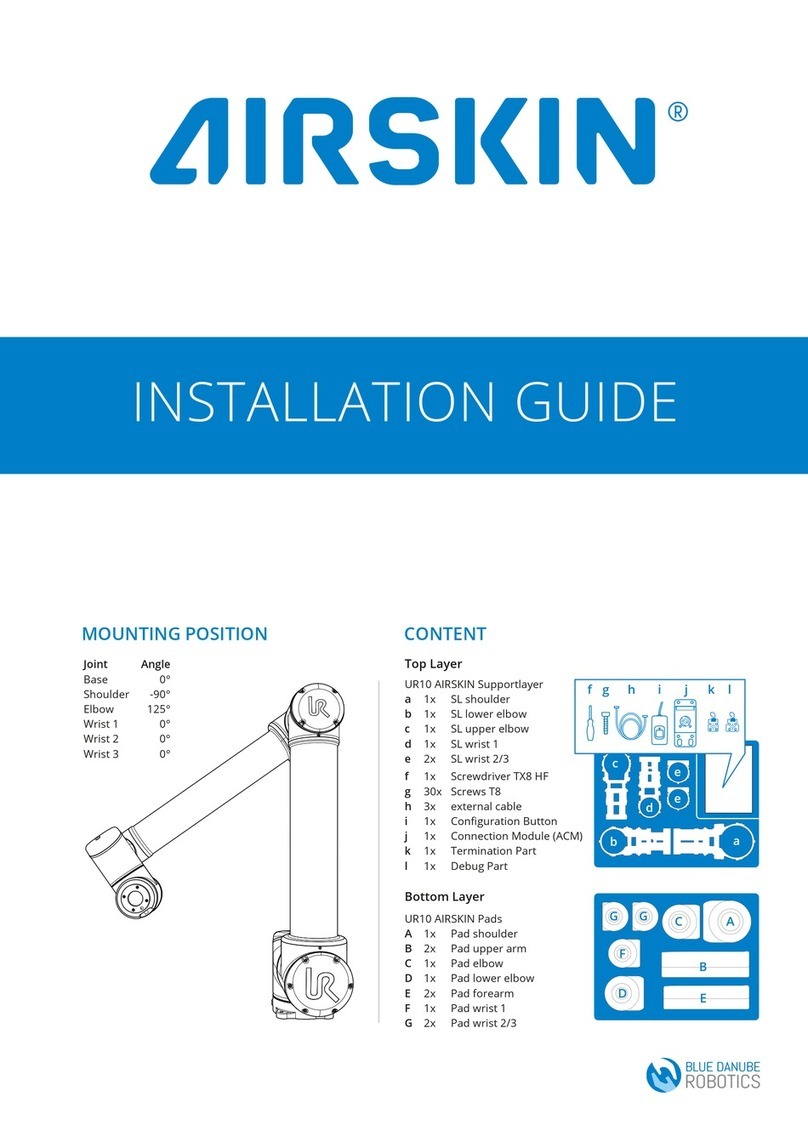
BLUE DANUBE ROBOTICS
BLUE DANUBE ROBOTICS AIRSKIN installation guide
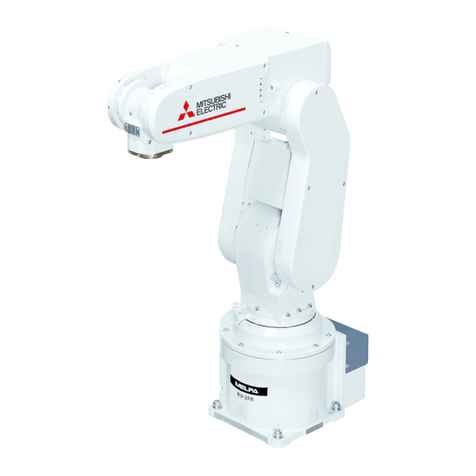
Mitsubishi Electric
Mitsubishi Electric MELFA RV-FR Series instruction manual
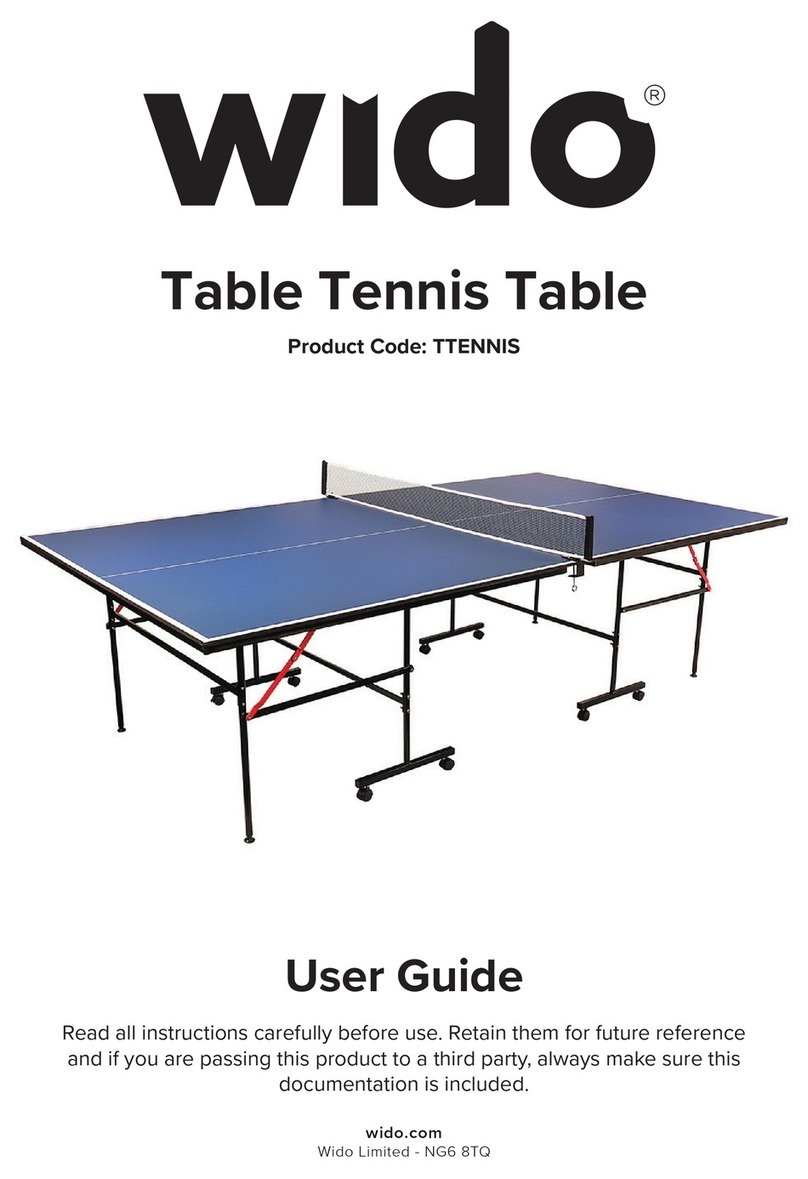
Wido
Wido TTENNIS user guide

RoboSea
RoboSea BIKI quick start guide
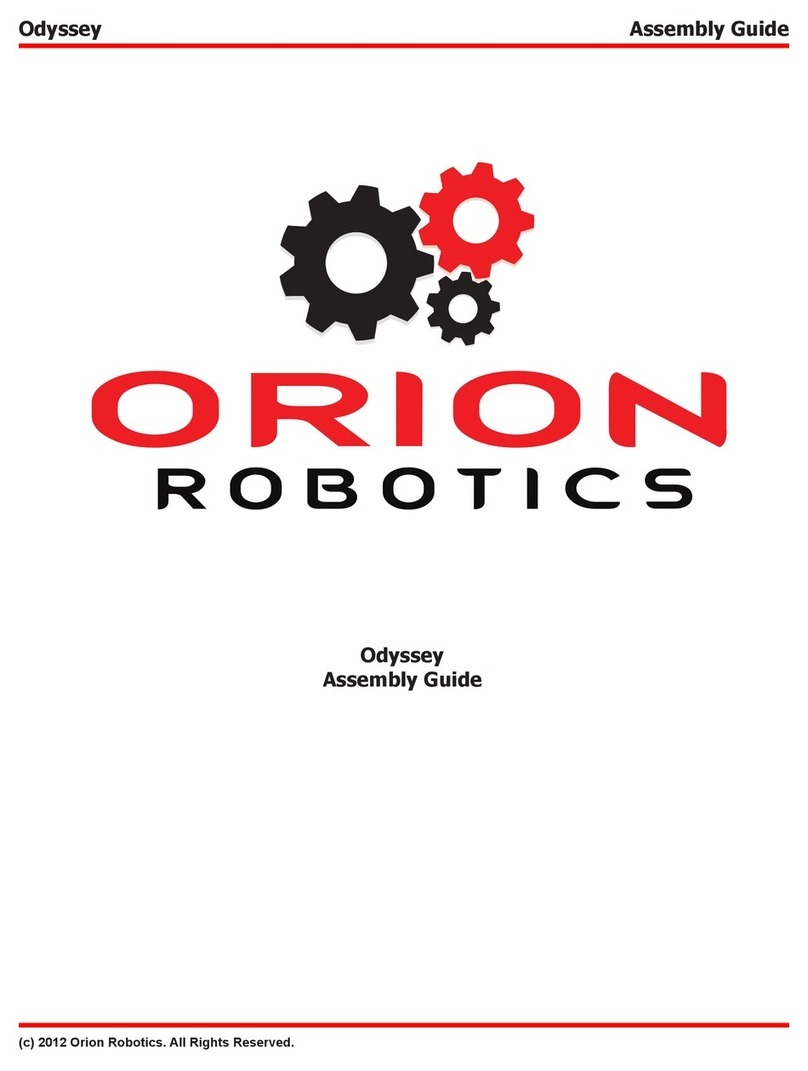
ORION ROBOTICS
ORION ROBOTICS Odyssey Assembly guide
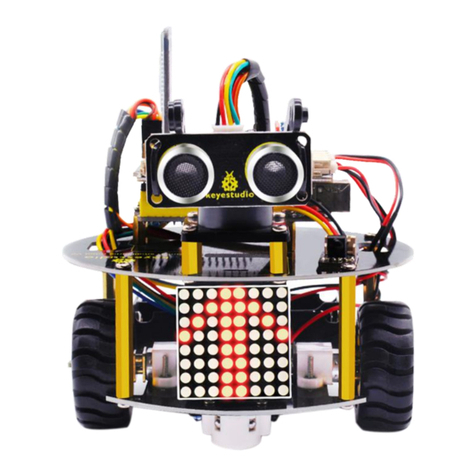
Keyestudio
Keyestudio Smart Little Turtle Robot V3 manual
